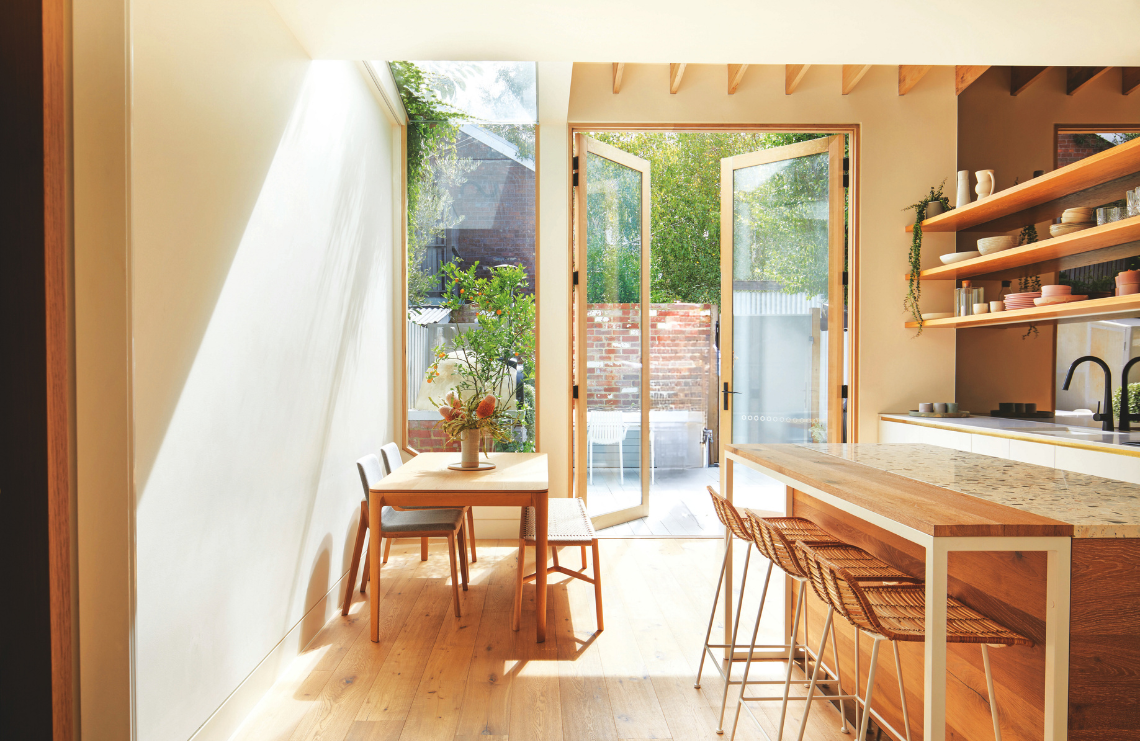Inner-city living was the dream for this family of three and nothing, not even a small, dark, drab-looking terrace, was going to stifle their vision of the perfect, functional family home. Stepping into this cleverly renovated Richmond abode, you are instantly transported into a spacious escape far from its dim origins. Each room of this bright and airy house features thoughtful pockets of space where natural light pours in, perfectly capturing the family’s original brief.
Balancing Warmth and Texture
The soft timbers of the kitchen delicately contrast with the concrete and stonework of the bathrooms, giving the home a warm, inviting and homely appeal — a big plus for the owners. “The main inspiration of the house was the constraints and challenges of the site,” says Sally Timmins, co-director of Timmins+Whyte. “This included getting light into the darker central spaces and allowing air into each room, including the bathrooms.”

Clever Use of Space and Functionality
With a challenging brief from the owners to include two bathrooms, a new kitchen with scullery, laundry, three to four bedrooms and plenty of storage in the home’s small structure, Timmins+Whyte beautifully overlayed spaces and moved away from the common open-plan living design. “We did not try to cram everything in to achieve open-plan living,” says Sally. “There were further benefits in doing this as it allows for acoustic control, breakout spaces when entertaining, and the benefit of using the sunniest space with a connection to the outside where the owners spend most of their daylight time, retreating to the living room at night.”
The designers and builders retained the double-storey heritage building. They then demolished the kitchen, bathroom, and outhouse, including the laundry and toilet. Additionally, an extension housed the new kitchen with scullery and a European laundry. A small powder room was also added off the entry hallway. Furthermore, one downstairs room was transformed into a new separate living area. Throughout the house, clever design introduced unexpected pockets of space where natural light filters in, enriching both form and function.
In the new warm, spacious and relaxing home, each nook is purposefully used for both storage and aesthetic appeal, especially the open shelving in the kitchen that subtly sits across the large bronze mirrored backsplash. The mirror not only expands the room visually but also reflects the beauty of the outdoors. “The colour of the mirror changes throughout the day and adds warmth and depth to the space,” says Sally. “The palette of materials was chosen to be unfussy and promote a sense of warmth and relaxation.”

Innovative Use of Light and Space Design
The home’s designers embraced unusual shapes, with each window cupping sunlight and bouncing it around the white walls. Consequently, this creates a sense of space and connection with the outside. Additionally, the dramatic glass ceiling stretches into the dining room, giving the home a greenhouse feel. Finally, the large timber-framed doors lead into the back courtyard, revitalizing the previously tight space.
“Our favourite parts of the addition are the pockets of light now coming into the heart of the house thanks to the frameless glass roof and window,” says Sally.
Continuing outside, a well-placed courtyard between the existing and new addition allows light and ventilation into the kitchen’s new scullery, two bathrooms, two bedrooms and the living room. “By building to the boundary on both sides and making the most of the north-facing rear wall with mostly glass, we could get light into the darker central spaces,” says Sally.

Eco-Friendly Design and Harmonious Exterior
The home’s natural-toned Colorbond cladding ties the exterior and interior tones together, emphasizing the addition’s vertical nature. In contrast, the rooftop garden softens the strong lines of the cladding. Furthermore, plants gently cascade down the facade, creating artistic shadows against the grey.
While tenderly blending with its surrounds, the home also has an eco-conscious design,
with both passive ventilation and heating major drawcards.
With a slight change in the kitchen and dining’s outdoor design — an awning had been cascading plants provide much-needed shelter and protection for the home’s external glazing throughout the seasons. The addition of ceiling fans in the main bedroom and an openable skylight also helps minimise heat build-up.

Overcoming Site Challenges and Collaborative Solutions
Given the site’s naturally long and narrow shape, the builders’ main challenge was restricted access for trades. The only two access points were the small front door and the tight laneway at the back. To overcome this, the builders from Align Concepts were able to coordinate with a friendly neighbour to allow the use of their property.
“We loved the build process when the clients could walk through the framework and start to feel the volumes and spaces, as well as see the views we framed through each window and opening,” says Sally. “We often hear the same remark: ‘Oh wow, we didn’t realise this was … quite so tall, large, framed’ etc.”

















